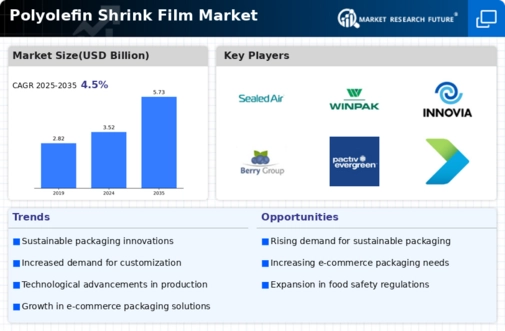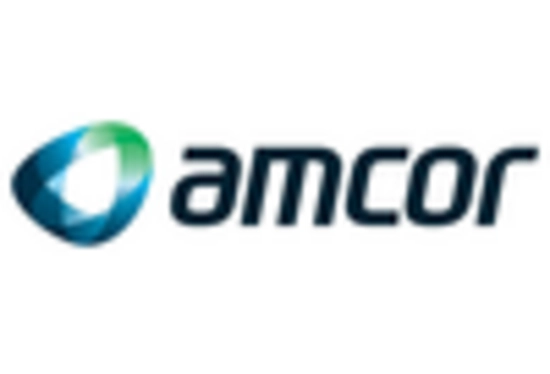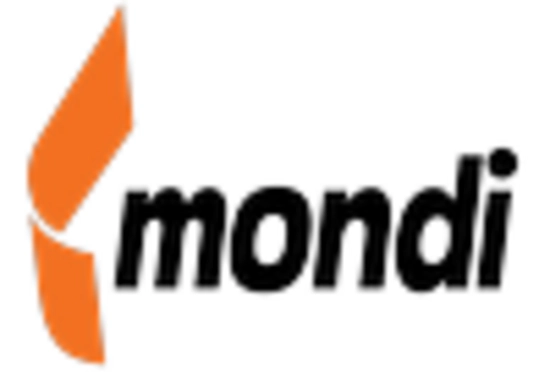Rising Demand for Flexible Packaging
The increasing preference for flexible packaging solutions is a notable driver in the Polyolefin Shrink Film Market. As consumers seek convenience and portability, manufacturers are responding by adopting polyolefin shrink films for their lightweight and adaptable properties. This shift is evident in various sectors, including food and beverage, where the demand for ready-to-eat meals and snacks has surged. According to recent data, the flexible packaging segment is projected to grow at a compound annual growth rate of approximately 4.5% over the next few years. This trend indicates a robust market potential for polyolefin shrink films, as they offer excellent barrier properties and aesthetic appeal, making them suitable for a wide range of applications.
Growth in E-commerce and Retail Sectors
The expansion of e-commerce and retail sectors significantly influences the Polyolefin Shrink Film Market. As online shopping continues to gain traction, the need for effective packaging solutions that ensure product safety during transit becomes paramount. Polyolefin shrink films are increasingly utilized for their ability to provide tamper-evident seals and enhance product visibility. Market analysis suggests that the e-commerce packaging segment is expected to witness a growth rate of around 5% annually, driven by the rising number of online transactions. This growth presents a substantial opportunity for polyolefin shrink films, as they cater to the unique packaging requirements of e-commerce businesses, ensuring that products arrive in pristine condition.
Regulatory Support for Packaging Innovations
Regulatory frameworks promoting innovative packaging solutions are a key driver in the Polyolefin Shrink Film Market. Governments worldwide are increasingly implementing regulations that encourage the use of advanced packaging materials that enhance product safety and reduce waste. These regulations often favor the adoption of polyolefin shrink films due to their versatility and compliance with safety standards. For instance, recent legislative measures aimed at reducing plastic waste have led to a surge in demand for recyclable packaging options, including polyolefin films. This regulatory support is likely to foster innovation within the industry, as manufacturers seek to develop compliant products that meet both consumer expectations and legal requirements, thereby driving market growth.
Technological Innovations in Film Production
Technological advancements in the production of polyolefin shrink films are propelling the Polyolefin Shrink Film Market forward. Innovations such as improved extrusion techniques and the development of multi-layer films enhance the performance characteristics of shrink films, including clarity, strength, and shrinkage rates. These advancements not only improve the quality of the films but also reduce production costs, making them more accessible to manufacturers. Recent studies indicate that the introduction of new production technologies could lead to a reduction in manufacturing costs by up to 15%, thereby increasing the competitiveness of polyolefin shrink films in various applications. This technological evolution is likely to attract more players to the market, further stimulating growth.
Sustainability Initiatives and Eco-friendly Materials
The growing emphasis on sustainability is reshaping the Polyolefin Shrink Film Market. As consumers and businesses alike become more environmentally conscious, there is a rising demand for eco-friendly packaging solutions. Polyolefin shrink films, which can be recycled and are often produced from renewable resources, align well with these sustainability initiatives. Market data suggests that the demand for sustainable packaging is expected to increase by approximately 7% annually, as companies seek to reduce their carbon footprint. This trend not only encourages the development of biodegradable and recyclable polyolefin films but also positions them as a preferred choice for environmentally responsible brands, thereby enhancing their market appeal.

















Leave a Comment